Outside In: Songs of Identity & Dignity for Eastern Indonesians in Java

This post comes from Chris Foertsch. Chris is a recent MA graduate from Oregon State University in Anthropology, currently in Indonesia on a Fulbright Research Fellowship to conduct preliminary fieldwork for his PhD, beginning 2018 at University of Victoria, BC. Besides ethnographic research interviewing, he likes cycling, exploring cities on foot, and drinking strong coffee.
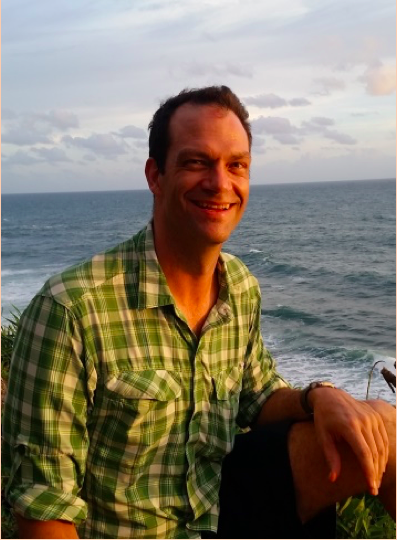
Outside In: Songs of Identity & Dignity for Eastern Indonesians in Java
“I hear Easterners don’t like dangdut music verymuch, but I don’t know many other Indonesian songs. Do you know ‘Terajana?’” I pulled out the lyrics to the classic of the genre by Rhoma Irama, the “King of Dangdut,” as Jeri struggled to tune the strings of his guitar, which was warped by the tropical climate and battered by life in the boarding house of rowdy college boys. We were on the second floor balcony of the rooming house he shared with a dozen or so other students, including his younger brother, and Jonas, who was making us coffee.
“Yeah, I think I know how to play that one,” he replied, not mentioning whether he liked it or not.
A campy golden oldie from the 1970’s about the joys of singing and dancing to dangdut music, “Terajana” (Weintraub 2008, Decker 2016) was an unlikely choice for an Indonesian college student and a 30-something American academic to sing together, but it happened to be where our musical knowledge intersected. Sometimes finding a mutual connection trumps being cool. So we worked it out together, writing the chords on the lyrics sheet, remembering how to phrase the chorus, where to repeat the first verse. By the time his housemate Jonas joined us again with coffee, Jeri and I had sung it together twice, and I was trying my hand at playing the guitar. Jonas was pleased to see us breaking the ice, and it didn’t take much convincing for him to join us in a third rendition of it. On the fourth try, we were feeling comfortable enough to really belt out the melodramatic first lines, “Tera-JA-naaaa…. Tera-ja-NAAAAA!”
“Terajana” is a song I had been practicing in an extracurricular culture class I was taking as part of a language scholarship in Malang, a city in Java, Indonesia. In the evening and on weekends I was also conducting interviews for my thesis, an ethnography of students from peripheral Eastern islands of Indonesia who attend university on the central island of Java (Foertsch 2016). Friends introduced me first to Jonas, whom they knew through his active role in student government. He fit the profile I was looking for, coming originally from the small Eastern Indonesian island of Adonara in the Province of Nusa Tenggara Timur (NTT). After our one-on-one interview together, he helped me organize a focus discussion with him and five of his housemates, including Jeri. They were all from various Eastern islands—Flores, Adonara, and the remote Kai Archipelago—studying at various universities in Malang. A week after the focus discussion, I bumped into Jonas one night walking through his neighborhood, and thirty minutes later I was at his kost singing “Terajana.”
The focus group had been interesting for all of us, but also very awkward. It was early in my field work, I was still new to interviewing, and my Bahasa Indonesia was still rudimentary. Plus I made a critical mistake in choosing a venue. Whereas the sing-along with Jeri and Jonas took place in the familiar territory of their home, the panel met me at a café frequented mostly by Javanese and Indonesian-Chinese young people from wealthier socio-economic circles. Since I was paying for our drinks, everyone politely ordered sugary sweet coffee and juice creations, fancier and pricier than the simple kopi tubruk coffee offered at the humbler warkop coffee stalls in their neighborhood.
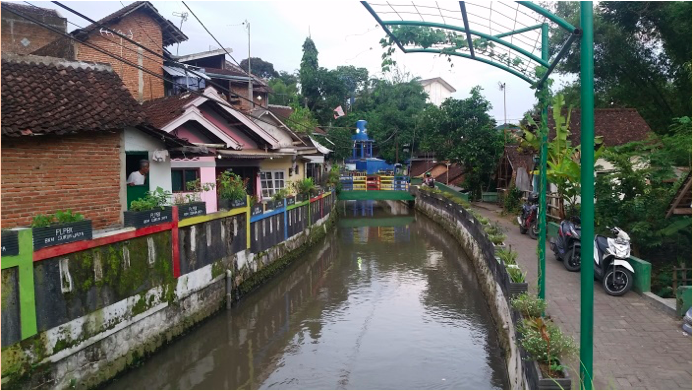
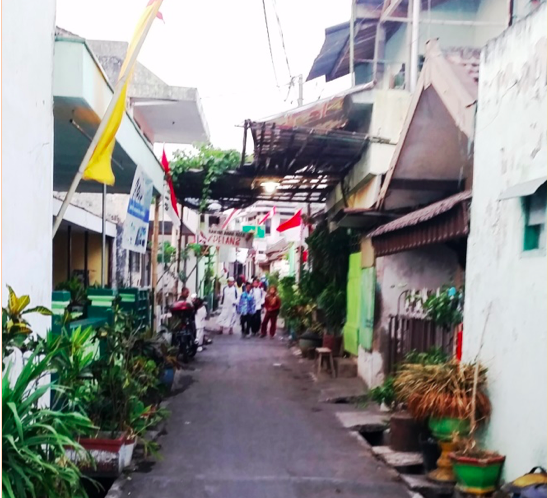
Jalan tikus “mouse streets” in neighborhoods of Malang, Java, Indonesia. Photo credit: Author
The music was different than where they lived too. Among the narrow alleys called jalan tikus (literally, “mouse streets”) in urban kampung neighborhood villages like where they lived, I often heard music that reminded me I was in Java. Dangdut is a widely popular genre especially among the lower classes in Java and many parts of Indonesia (Weintraub 2010), but generally less well liked in Eastern parts of the country. Campursari is a relatively newer genre, popular in Java, combining elements of dangdut, rock, and other influences. Occasionally I passed middle aged and elderly residents listening to recordings of traditional gamelan ensemble orchestras, the refined classical Javanese music played for its own sake and to accompany other traditional performing arts—wayang shadow puppet theater, dance, and even martial arts. During our interview that night, the usual mix of recent Billboard favorites played, as heard in Java’s malls, airports, cafes, and other “modern” spaces. For example, One Direction’s “Perfect,” Maroon 5’s “Sugar,” Taylor Swift’s “Blank Space,” or any of a dozen other heavily rotated tracks that tended to get stuck in my head that summer of 2015. These songs played ad nauseum for urban middle and upper class Indonesians in places that reflect a placeless, flavorless global cosmopolitanism.
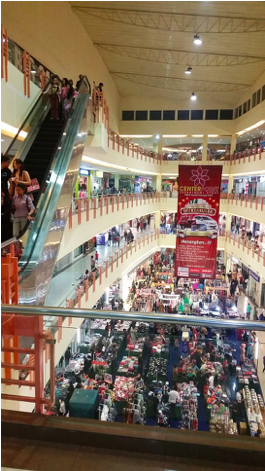
One of several malls in Malang, Java, Indonesia. Photo Credit: Author
As the interview got underway, I started with general questions about how they chose to come to Java, what they liked and didn’t like about Malang, and some of the guys (all boys) were more eager than others to share their answers to my questions. Ever the diplomat, Jonas did his best to help me facilitate the conversation and clarify my sometimes opaque questions to his fellows. I struggled to transition to the deeper, more sensitive questions, until after an hour I finally forced this question into our interview:
“So, is there any discrimination by Javanese people against you because you’re from Eastern Indonesia?”
It was the moment in the movie when the needle scratches off the record. Instead of crickets chirping in the tense conversation vacuum, there was chatter from nearby tables of Javanese students, the sound of motorbikes passing on the street below, and one or another of the top 40 ear worms playing in the background. Also in that tense wordlessness, an unmistakable whiff of nervous sweat reached my nose, a primal, human scent, indicating danger and the preparation to fight or flight. After a few beats, one boy gave the obvious answer in two short syllables.
“Ada,” he said. There is.
The bravest of the group shared a few quick examples, but didn’t elaborate. I’d cut too deep, hurt their feelings, and I’d made them Outside others again, after I’d invited them In for coffee and conversation. Jonas and I did our best to recover the mood, to save our collective face, but the exchange left us uncomfortable.
Students like Jonas, Jeri and their friends from Eastern parts of Indonesia come to Java, the “Center” of their country to access higher quality education than can be found in the outer provinces. They also come for an adventure, to merantau—to “wander” in search of their fortune, away from parents and their native villages, in the cities of the Pusat Negeri, the Center of the Country.
Hearing Eastern Indonesian students in Java explicitly describe their migration to the Center from Outer Islands evokes the notion of “core” and “periphery” societies, which emerged from the work of Wallerstein (1974, 2004) and others, who apply the core-periphery dynamic on a global scale. But it can also be seen on a regional level in a country like Indonesia, with “core areas of capital and technology” in Java that control and extract resources and labor from “peripheral areas” (Dove and Kammen, 621). This includes human resources, such as educational migrants like Jeri, Jonas and their friends who come from poor, rural, peripheral islands.
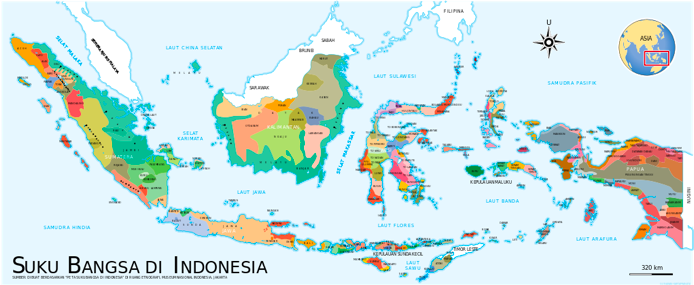
Map of “Ethnic Groups in Indonesia” illustrates the immense cultural diversity of the country. Photo credit: By Gunawan Kartapranata - Own work based on the map in Ethnography Room, National Museum of Indonesia, Jakarta, CC BY-SA 3.0, https://commons.wikimedia.org/w/index.php?curid=11485259
The Easterners and other so called “pendatang” to Java—translated as “newcomers, immigrants, outsiders”—(“History Malang | Malang” 2016) are among the hundreds of minority ethnic groups that make up one of the world’s most culturally and linguistically diverse societies, spread across a vast archipelago of 17,000 islands (Manns, Cole, and Goebel 2016, Vickers 2013, Elson 2008). Many Easterners are double minorities, practicing Catholic or Protestant faiths in a country that is 87% Muslim (“The World Factbook — Central Intelligence Agency” 2017).
On Java, pendatang do find opportunities and adventure, but they also find discrimination, both overt and discreet, related to their different looks, behavior, traditions, religion, and other characteristics. Students reported different degrees of this, depending on their individual circumstances. Informants’ experiences included difficulty finding housing, name calling denigrating their dark skin and curly hair, and perceived exclusion from conversations when locals chose to use the Javanese language, rather than the common national language, Indonesian. Meanwhile, Javanese acquaintances of mine often repeated some of the stereotypes about supposedly rude, drunk, belligerent, and lazy students from Maluku, Papua, and NTT, citing news-making recent conflicts and clashes including Easterners (Wahyunik 2016).

A student from Sumba, NTT in Eastern Indonesia poses in front of police car on the afternoon he and more than 200 others from his part of Sumba were to be removed from the city of Malang, after a conflict between students left one dead in March 2016. Photo credit: Hayu Yugha Prabowo for Surya Malang.
Back on Jonas and Jeri’s balcony, I didn’t directly observe any belligerence or drunkenness. However, there was plenty of cigarette smoking along with our coffee, and the singing was perhaps a bit loud for the neighbors across the alley.
By the time we had mostly finished our coffee and sung “Terajana” a couple more times, two or three of their housemates had joined us on the balcony. We took a break from singing to have a slightly more casual conversation than at the café. Jeri’s younger brother Antonius was mostly quiet, as he had been at the café the week before. He had been in Malang less than two months, and as a “junior” (adik—younger sibling) in the social pecking order, he deferred to his brother, Jonas, and his other “seniors” (kakak—older siblings), usually only speaking when asked a direct question, and occasionally fetching things his elder kakak asked him for, cigarettes and a lighter for example. Charismatic Jonas had been in Malang for three years, and was the ranking kakak of the group talking to me on the balcony, leading our conversation and giving subtle signs to the others to encourage their participation or have them wait their turn. Our interactions were still a bit stiff, given our age and cultural differences, and the language barrier of course, but we were more comfortable, and enjoying the exchange more than when I had bluntly asked them about discrimination at our previous meeting. They asked me about America, why I was so interested in Indonesia, and a couple of them tried out their English with me.
The atmosphere changed when the most senior kakak arrived. Pablo is from Timor Leste, the country that shares a land border with Indonesia on Timor Island and recently gained independence in 2002, after decades of brutal military occupation. He had tattoos and a tough attitude about him that differed from his Eastern Indonesian juniors, his adik, who automatically gave up a seat for him on the balcony. Wiry and outspoken, he didn’t seem awkward or self-conscious about my presence. He hadn’t been at the café the week before, so Jonas introduced us and explained who I was. Everyone’s focus shifted to Pablo, who now directed the conversation, asking me a few questions, and eliciting a story from me about a time I had traveled with friends on the Indonesian side of Timor Island in a remote area near the border. Technically, I had visited his country when I stepped over the unguarded barrier for friends to take my picture as I stood in Timor Leste territory. My story made him laugh, and this seemed to relax his adik, a signal that their kakak approved of me.
Pedro made song requests to Jeri, who complied with an eclectic variety reflecting their musical tastes, including Western rock, Bollywood, folk songs, and even a few he had written himself. We sang the Scorpions’ “Wind of Change” twice together, looking at the lyrics on our smart phones, and collectively chuckling at our missed high notes. Before our second rendition, they asked for translations of certain vocabulary, which led me to an explanation of the song’s role in history, how it became an anthem for the end of the Cold War. I glanced at Pablo, wondering if my description of the reunification of Germany held any reverse resonance for him, given his country’s relatively recent independence from Indonesia—re-division rather than reunification. I didn’t ask. I’d learned from my “discrimination” faux pas not to be a buzzkill.
The peanut gallery sang along with Jeri and his nearly tuned guitar, mumbling or humming when they forgot the words, or bobbing their heads when it was in a language they didn’t know. For the song he’d written himself, he was on his own, a lovesick theme about his girlfriend back on Kai Kecil, sung in his mother tongue. A few more songs from Maluku followed that the Kai Islanders sang along with, while the others from NTT could join on the chorus. I just listened, not understanding the lyrics, but hearing the nostalgia in their young voices, seeing the homesickness on their faces. Folk songs about their islands, they let me know. I was honored that they felt comfortable singing their songs together in front of me, a witness, sharing a moment of musical and emotional resonance: of course not one of them, but next to them, as a friend and guest.
During a pause in singing and talking, Pablo read the mood right and started a song they all knew the Indonesian lyrics to.
“Hitam kulit keriting rambut, aku papua.
Biar nanti langit terbelah, aku papua.”
“Black is my skin, curly my hair, I am Papua.
Even if the heavens should tear apart, I am Papua."
Though none of these young men are from Papua, on the island of New Guinea, the song “Aku Papua,” popularized by Edo Kondologit speaks to their common experience and affirms their identity and dignity as Easterners (Smythe 2013).
These were songs they considered theirs, about themselves. Songs of connection to their home islands and family in the East, places most of their neighbors and classmates in Java would never see, and might never hear of. On the balcony of their kost it was safe to sing their songs and take a sentimental journey back home for an hour or two. Their Javanese neighbors had dangdut, campursari, and gamelan to define their place and identity. Perhaps the cosmopolitans in the café and the mall had Maroon 5 and Taylor Swift to define their commercial public spaces and socioeconomic aspirations. But at home, the young men from Flores and Kai could sing about themselves with nostalgia, with pride, and with joy.
It was getting late, and I didn’t want to wear out my welcome, so I said I needed to get going. I thanked them for the hangout, and for sharing their songs with me. They acknowledged and appreciated me too, then Jonas, Jeri, and a couple others offered to walk me home. But we needed to finish on a high note, and they wanted to include me too. We came together again for a last call that we all knew the words to, not their kind of music, nor mine really. But some songs are just fun to sing together, no matter the genre, no matter where you’re from. One more round of “Terajana.”
References:
bachtiar djanan. 2017. Edo Kondologit - Aku Papua (Cipt. Franky Sahilatua). Accessed May 14. https://www.youtube.com/watch?v=Nad-VQT0dEw.
“Badan Pusat Statistik.” 2016. Accessed March 18. http://www.bps.go.id/linkTabelStatis/view/id/1267.
Decker, Andrea Louise. 2016. “Performing Gender to Dangdut’s Drum: Place, Space, and Infrastructure in Indonesian Popular Music.” http://escholarship.org/uc/item/8q7181qr.pdf.
Dove, Michael R., and Daniel M. Kammen. 2001. “Vernacular Models of Development: An Analysis of Indonesia under the ‘New Order.’” World Development 29 (4): 619–639.
Elson, R.E. 2008. The Idea of Indonesia : A History. Cambridge, U.K., New York: Cambridge University Press.
Foertsch, Christopher R. 2016. “Educational Migration in Indonesia: An Ethnography of Eastern Indonesian Students in Malang, Java.” http://ir.library.oregonstate.edu/xmlui/handle/1957/59445.
“History Malang | Malang.” 2016. Accessed May 11. http://malangkota.go.id/sekilas-malang/sejarah-malang/.
Manns, Howard, Deborah Cole, and Zane Goebel. 2016. “Indonesia and Indonesian.” In Margins, Hubs, and Peripheries in a Decentralizing Indonesia, 17–25. Hong Kong.
ScorpionsVEVO. 2017. Scorpions - Wind Of Change. Accessed May 14. https://www.youtube.com/watch?v=n4RjJKxsamQ&feature=youtu.be.
Smythe, Julian. 2013. “The Living Symbol of Song in West Papua: A Soul Force to Be Reckoned With.” Indonesia 95 (1): 73–91. doi:10.1353/ind.2013.0000.
STARZLISITY FAZZ. 2017. Rhoma Irama “ Terajana ” (With Lyrics) HD. Accessed May 14. https://www.youtube.com/watch?v=fOqjIB3F660&feature=youtu.be.
“The World Factbook — Central Intelligence Agency.” 2017. Accessed May 14. https://www.cia.gov/library/publications/the-world-factbook/geos/id.html.
Vickers, Adrian. 2013. A History of Modern Indonesia. 2nd ed. Cambridge, UK: Cambridge University Press.
Wahyunik, Sri. 2016. “Mahasiswa Ini Berpose Di Depan Mobil Patwal Polisi Sebelum Dipaksa Pulang Ke Sumba NTT.” Surya Malang. March 23. http://suryamalang.tribunnews.com/2016/03/23/mahasiswa-ini-berpose-di-depan-mobil-patwal-polisi-sebelum-dipaksa-pulang-ke-sumba-ntt.
Wallerstein, Immanuel. 1974. Modern World-System I Capitalist Agriculture and the Origins of the European World-Economy in the Sixteenth Century. Berkeley, California: University of California Press.
———. 2004. World Systems Analysis: An Introduction. Duke University Press.
Weintraub, Andrew N. 2008. “‘Dance Drills, Faith Spills’: Islam, Body Politics, and Popular Music in Post-Suharto Indonesia.” Popular Music 27 (3): 367. doi:10.1017/S0261143008102185.
———. 2010. Dangdut Stories: A Social and Musical History of Indonesia’s Most Popular Music. Oxford University Press.





